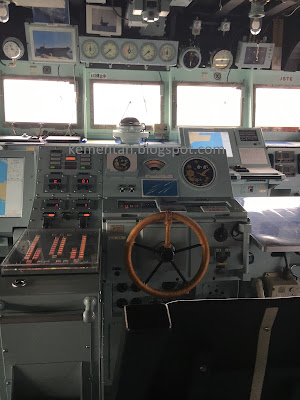Operational and technical matters aside, the failure to recognise the extent to which its naval code had been compromised by Royal Navy and United States Navy cryptographers and inadequate anti-submarine protection also contributed to the loss of many IJN vessels.
An opportunity to tour the JS Kaga showed that the ship's designers have incorporated lessons learned from aircraft carrier operations in the past. Kaga is the second of the two-ship Izumo-class, which are the largest surface combatants in the Japan Maritime Self-Defense Force (JMSDF).
Hurricane bow: The enclosed bow was a feature of the British Pacific Fleet's fleet carriers. This design feature improves sea keeping in heavy seas. Only one IJN aircraft carrier, Taiho, had her bow fully enclosed. JMSDF Izumo-class helicopter destroyers and the smaller Hyuga-class helicopter destroyers were built with enclosed bows.
Island superstructure: You might think an island on the flight deck of an aircraft carrier helicopter destroyer is a basic necessity. But IJN carriers like the Zuiho-class, Ryujo, Ryuho and smaller Taiyo-class escort carriers among others dispensed with the island totally, making these ships quite literally flattops. Over in England, the Royal Navy's WW2 aircraft carrier, HMS Argus, was also built with a flattop and no island superstructure.
IJN carriers such as the Akagi and Hiryu had their islands built on the "wrong side", i.e. on their port side when designs of the period all tended to place the island on the starboard side of the carrier. The reasoning was that the landing pattern for Akagi and her carrier division partner, Kaga, could take place simultaneously with both carriers sailing alongside.
The vertical funnel trunked within the JS Kaga's superstructure marks a departure from previous Japanese designs that had a curved funnel that vented the exhaust efflux downward towards the sea. JS Kaga follows current design convention where the island superstructure is offset to starboard.
Hangar and elevator deck: JMSDF Izumo-class ships have two methods to move her air group from the hangar to the flight deck. Helicopters can be lifted by the elevator or deck edge lift. Note that US Navy Nimitz-class carriers have ditched the deck elevator totally, with her designers opting instead for the deck edge lifts. Among the advantages of the deck edge lifts is the freeing up of precious hangar space. Kaga's deck plan above shows that the deck elevator well occupies about 20% of the floor area on the hangar deck. Deck edge lifts also allow oversized aircraft to move between hangar and flight deck, without dimensional limits imposed by the deck elevators. In addition, there is a school of thought that the deck elevators compromise the integrity of the flight deck with the large opening.
During the Pacific War, dive bomber pilots used to aim their bombs at the carrier's deck elevators as a successful hit on the elevator would have a better chance of penetrating to the hangar deck. IJN carriers such as the Hiryu and Taiho both had their elevators inoperable/jammed after dive bomber and torpedo attacks.
Kaga's deck plan also shows that the hangar deck can be sub divided into four separate compartments. This improves the ship's survivability by preventing fires from spreading quickly in the hangar as the compartments are screened off from one another by blast-proof doors.
Kaga's deck elevator takes about 20 seconds to move from the hangar to the flight deck.
Kaga's hangar, looking towards the bow and the deck elevator in "down" position. When Kaga is closed up for action stations, the view forward would extend till the first row of blast-proof doors that will move into position on rails visible on the hangar roof, at the frame just before the yellow forklift on the ship's portside.
A single blast door is used to seal off the hanger from the deck edge lift, turning the hangar into an armoured box. Note the arrangement of pulleys at the left side of the door. The US Navy's USS Wasp (CV-7) successfully pioneered the use of a deck edge lift and this feature was added to the Essex-class fleet carriers.
Eleven panels of blast-proof doors seal off a compartment on Kaga's hangar deck. On US Navy Nimitz-class carriers, the conflagaration or CONFLAG stations seal off their sections using blast doors that move into position from either side of the hanger. On Kaga, these doors roll into place from the ship's portside. Such doors prevent fire from spreading quickly throughout the hangar, isolating damage within sealed compartments for fire-fighting and damage control teams to deal with.
Inside Kaga's spacious wheelhouse, with flat screen navigation panels and the ship's wheel (below). Air traffic control and deck handling areas for embarked helicopters are located in a separate station aft of the superstructure. During the Pacific War, experience aboard IJN fleet carriers like Akagi and Kaga showed that their small island superstructure had inadequate space for ship and aviation control functions.
Note the compartmentalised sections in Kaga's hangar, deck edge lift and the space taken up by the deck elevator forward.
Despite the readiness of Japanese ship designers to embrace features such as the hurricane bow, enlarged island, deck edge lift, improved FFDC and sectionalised hangar space found on foreign aircraft carrier designs, some traditions have been retained on Kaga. JMSDF ships continue to use bugle calls to sound activities like flag raisings and salutes.
You may also like:
Yashukan War Memorial Museum shows Japan's road to war. Click here
Visit to the Hikawa Maru Museum. Click here
Visit to Yashukan War Memorial Museum. Click here















1 comment:
By sheer coincidence Singapore’s television media news is running three video advertorials for the F-35, even quoting the price of the F-35B (LRIP lot 11) in SGD.
The world wonders.
Post a Comment